- Tata Motors
- Global NCAP
- Safer Choice Award
- Tata Safari
- Tata Harrier
- Vehicle Safety
- Passenger Cars
- SaferCarsForIndia
Innovative G-Python
- By Bhushan Mhapralkar
- October 08, 2021
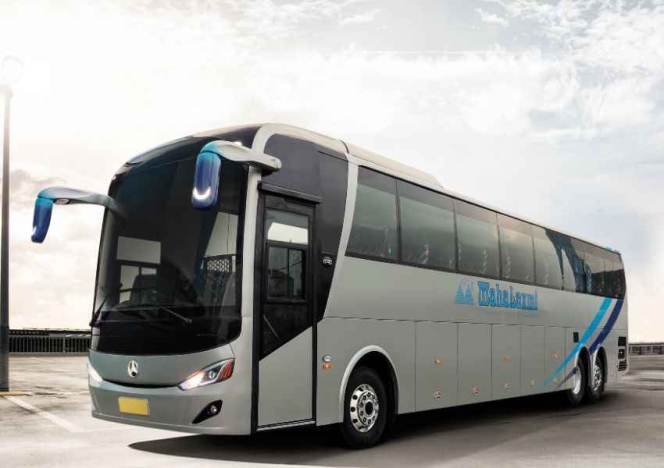

A good 15m long, the Mercedes-Benz OC 500 RF 2542 has two-axles at the rear and one at the front. Its name suggests it to be German. It is therefore perhaps that a European influence is evident from the smooth surfaces and well-defined lines of the G-Python’s exterior design. The standards of fit and finish are good. A sense of sleek and muscular build apparent from the vehicle’s exterior design, the G-Python, according to Kukreja, draws inspiration from the python’s prowess and size. He drew attention to the fine curves and added, “Look carefully at the headlamps; they will remind you of the eyes of a python. They shine like diamonds”. Reflecting luxury, style and an ability to stand out, the sleek and sweeping headlamps of the G-Python coach body work make an interesting part of the facia. The facia in turn has a large windshield with a black theme patch at its bottom. The pasted windows and tall sides of the G-Python nicely complement the facia design, highlighting a good sense of proportion in the process. Like a fully grown python – a reticulated python (Malayopython reticulatus) can reach over 6.25m in length and is termed as the longest snake in the world – the G-Python luxury coach design does appear long and attractive on the Mercedes-Benz multi-axle chassis.
Finer detailing
Powering the Mercedes-Benz OC 500 RF 2542 is a 388 hp, six-cylinder Mercedes-Benz OM 470 Euro VI 10.7-litre diesel engine situated transversely at the rear. It is so located that it feeds power to one of the two rear axles. Its access is governed by an engine lid at the rear. When viewed from a three-fourth angle, the rear accommodates the engine compartment access lid nicely in a large black patch. Replicating the colour theme of the facia (there is a similar albeit smaller black patch under the windshield), the large rear patch of black cleverly hides the enormity of the coach structure. It is no doubt tall and fairly enormous when viewed against a car or a van! On either side of the black patch are sleek and stylish LED tail lamps. “True to our penchant for aerodynamic styling and discreet elegance, the G-Python coach design is based on a modular concept,” said Kukreja. “As much as the exterior, there’s much attention that has gone in the designing and building of the interior too,” he added. Containing diffused lighting, a warm shade of blue and white, the interior exudes a touch of luxury and elegance, much the same way the exterior does.

Employing CR tubes and fire retardant FRP material in its construction, the interior of the G-Python coach design offers good space between each seat row. The seats of the reclining variety are designed and positioned to offer maximum comfort and leg room for passengers. This makes for a relaxing atmosphere. Cabin isolation is brought up to speed with much use of insulation material. “There’s been a good deal of innovation that has gone into the noise isolation of the cabin,” averred Kukreja. With maximum luggage compartment space, easy to operate functions and a long list of optional features like heating, AC, LED screens, mobile-laptop charger, metallic paint, infotainment system, pantry and chemical toilet etc., the G-Python, when it comes to features, offers almost all the bells and whistles. “From the very inception of the design, we made sure that we could accommodate each and every feature that a coach operator could ask for,” Kukreja remarked. “The colour combination and graphics is optional.”

Stating that the attention to European standards has ensured superior built quality, Kukreja said, “From the safety point of view, we have made every effort to exceed the regulatory requirements.” The G-Python coach design employs a laminated glass windshield. The pasted windows on the sides are of the toughened variety. The emergency door has been situated at the rear. Conforming to the bus code, the G-Python seeks proximity to a European integral coach design. It is capable of seating 53 passengers. Available in ‘semi-sleeper’ guise as well, there are no plans to introduce a ‘sleeper’ version as of now. “We may offer a ‘sleeper’ version in the future,” said Kukreja.



An eye for quality
Built with close attention to quality at Guru Ram Dass Body Builders’ Sonipat facility in Haryana, the G-Python coach body design flaunts a super strong reinforced structure that is crash resistant. It is backed by a pan-India after sales support. Offering ease of maintenance and service through easy accessibility to key aggregates and parts, the luxury coach body design is subject to regular updating, according to Kukreja. “This is in line with our philosophy to keep improving a design and incorporate new developments in bus/coach body design and development,” he added. Explaining that his company’s modern plant at Sonipat has state-of-the-art paint booth, shearing and press brake machines, an R&D centre, shower booth and an FRP moulding facility among others, Kukreja said, “The build quality of the G-Python is in line with the company’s quality management system and regulatory requirements.”

Stressing on a robust quality control mechanism in place at GRD’s Sonipat plant to ensure thorough inspection of every material that is procured and every weld joint that is carried out on the structure, Kukreja expressed, “Trained professionals use calibrated measuring instruments and various other machines as part of the quality management system.” “There’s a ‘Red Table Area’ in the Sonipat plant where the selected and reject material are segregated,” he added. Explaining that the G-Python will complement the existing G-Dolfino bus body design, Kukreja averred, “They are more or less parallel offerings.” “The G-Dolfino was launched in 2019 and the G-Python was launched in June 2021,” he said. Asked if the G-Python coach body design would fit a 12m long front-engine bus chassis like the BharatBenz 1624, and Kukreja was quick to answer, “Modifications in the floor structure should make it possible.” Whether it would be done at once? Kukreja is not in favour it seems. “We will take a call on whether we want to offer the G-Python luxury coach body design on any other chassis than a rear engine multi-axle one,” he announced. “For the 12m long front-engine BharatBenz 1624, we have yet another fine design in the form of the G-Dolfino,” he concluded. The G-Dolfino, it should not take long to understand, is inspired by a Dolphin!

- SIAM
- Society of Indian Automobile Manufacturers
- Enhancing Efficiencies in Automotive Logistics
- Tapan Ghosh
SIAM Conclave Highlights Push for Sustainable Logistics in Indian Auto Sector
- By MT Bureau
- July 18, 2025

The Society of Indian Automobile Manufacturers (SIAM) convened its 11th Automotive Logistics Conclave today in New Delhi, spotlighting the shift toward more efficient and sustainable logistics in India’s fast-growing automotive sector.
Centred around the theme 'Enhancing Efficiencies in Automotive Logistics,' the event brought together key government officials, automotive leaders, and logistics service providers to deliberate strategies for building a resilient and eco-conscious logistics ecosystem.
Senior Railway Board official Hitendra Malhotra announced the introduction of specialised, higher-capacity railway wagons, including double-deck options tailored for SUVs, supporting increased vehicle transport needs.
Tapan Ghosh, Chairman of the SIAM Logistics Group and VP at Hyundai Motor India, noted that the sector has witnessed a 7.3% growth in FY 2024–25, attributing part of this expansion to enhanced logistics capabilities. Industry players highlighted a growing reliance on digital innovation, multimodal transport solutions, and rail-based logistics to increase efficiency and reduce carbon footprint.
S D Chhabra of Maruti Suzuki emphasised the integration of real-time tracking technologies and a broader push toward sustainability. Policy alignment and infrastructure development were also key focal points, with participation from leading firms including Mahindra & Mahindra, Ashok Leyland, Chetak Logistics, and APLL VASCOR.
The conclave reinforced SIAM’s commitment to green mobility, with discussions calling for industry-wide adoption of eco-friendly practices and regulatory coherence aligned with India's national sustainability goals.
Several logistics providers were recognised at the event for excellence in innovation and operations, underscoring the sector’s critical role in shaping the future of Indian mobility.
- Indian Racing League 2025
- IRL 2025
- Raoul Hyman
- Fabienne Wohlwend
- Laura Camps Torras
- Cailin Wood
- Ruhaan Alva
- Le Mans
- Neel Jani
- GP2
- Jon Lancaster
- Arjun Kapoor
- Naga Chaitanya
- John Abraham
- Sourav Ganguly
- Sudeep Kichcha
- Keerthivasan
- Akhilesh Reddy
Indian Racing League 2025 Kicks Off With First-Ever Driver Draft In Mumbai
- By MT Bureau
- July 15, 2025

The Indian Racing League (IRL) formally launched its 2025 season with a driver draft event held in Mumbai. This marked the first time a driver draft format was used in Indian motorsport, featuring the selection of 24 drivers across 6 city-based franchises, including international racers, Indian talent and women drivers.
Each team picked four drivers based on a fixed structure: one international driver, one emerging Indian or international talent, one Indian domestic racer and one female driver. Among the key names drafted were Le Mans winner Neel Jani, GP2 veteran Jon Lancaster, IRL champion Raoul Hyman and young Indian racers Ruhaan Alva, Sohil Shah and Akshay Bohra. Women racers such as Caitlin Wood, Fabienne Wohlwend and Laura Camps Torras also joined the grid, bringing diverse experience from series like the W Series, GT racing and F4.
The event also featured a joint press conference with all six team owners — including Arjun Kapoor, Naga Chaitanya, John Abraham, Sourav Ganguly, Sudeep Kichcha and Keerthivasan — who introduced their teams and outlined their plans for the season. Racing Promotions (RPPL) Chairman Akhilesh Reddy stated that the draft aimed to bring greater structure and inclusivity to Indian motorsport. The 2025 IRL season begins in August and will be held across city circuits and racetracks throughout India.
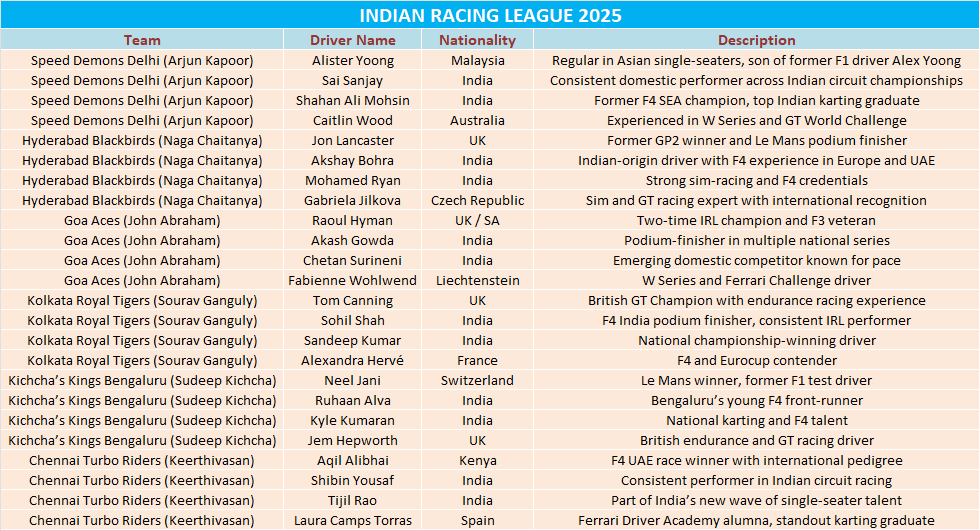
Auto Retail Grows 5% In June, FADA Maintains Cautious Optimism For Near-Term
- By MT Bureau
- July 07, 2025
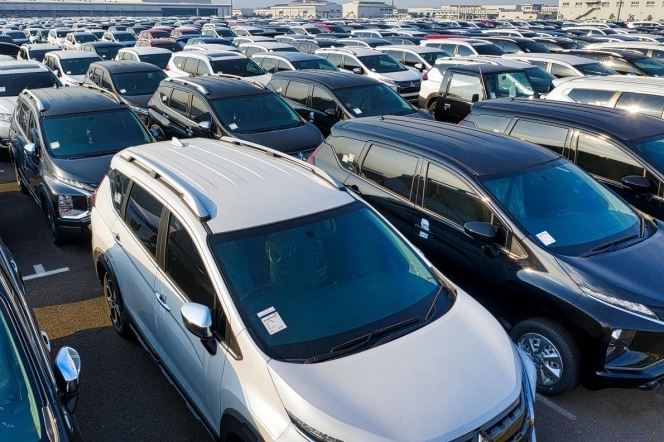
The Federation of Automobile Dealers Association (FADA), the apex body representing automotive dealerships in the country, has released the retail sales data for June 2025, which saw a total of 2 million vehicles sold in the country, which was 4.84 percent higher YoY, but 9.4 percent lower than the previous month.
Last month, two-wheeler sales continued to be in the green with 1.44 million units sold, as against 1.38 million units sold last year. Three-wheeler sales grew by 6.6 percent, while passenger vehicle sales at 297,722 units, saw a flattish growth of 2.45 percent YoY. Tractor sales at 8.6 percent, construction equipment at 54.95 percent and commercial vehicle with 6.6 percent showed signs of healthy growth.
C S Vigneshwar, President, FADA, said, “While two-wheelers showed some early-cycle softness, we remain confident of a robust ramp-up in the coming months as seasonal demand and targeted OEM initiatives take effect.”
He pointed out that while festival and marriage-season demand provided a boost, financing constraints and intermittent variant shortages moderated sales. Early monsoon rains and rising EV penetration also shaped buying patterns in the two-wheeler segment.
“Several dealers cited compulsory billing and forced stock lifts – often via auto-debit wholesales – leading to mandated high days of inventory aligned with festival-season targets. Overall, June demonstrated a resilient two-wheeler performance amid mixed market signals,” he noted.
In the passenger vehicle space despite elevated incentive schemes and fresh booking lent support, heavy rains and tight market liquidity impacted sales. “Some dealers indicated that certain PV OEMs have introduced compulsory billing procedures – such as automatic wholesale debits – to meet volume targets; inventory consequently stands at around 55 days. June thus painted a picture of modest but steadfast PV performance amid varied market cues,” Vigneshwar said.
The CV segment saw early-month deliveries buoy volumes before monsoon-induced slowdowns and constrained liquidity dampened inquiries and conversions. The impact of new CV taxation along with mandatory air-conditioned cabins has elevated ownership cost, alongside muted infrastructure demand.
Cautious optimism
Looking ahead, the retail body anticipates a period of mixed fortunes. Above-average monsoon rains in July, are expected to boost rural demand, particularly for two-wheelers, thanks to stronger farm incomes highlighted by an 11.3 percent YoY increase in Kharif sowing. However, intense rainfall in some regions could create logistical challenges.
Simultaneously, substantial government capital expenditure from June to August on infrastructure projects like roads, railways, metros and green energy initiatives will continue to support the CV and CE segments.
Despite these positive drivers, several headwinds remain. Evolving geopolitical tensions and potential repercussions from US tariff measures necessitate careful supplychain management and could dampen consumer confidence. Furthermore, scarcity of rare-earth materials is hindering component production, which in turn limits overall supply and retail volumes.
In the two-wheeler market, early monsoon showers and renewed rural activity have sparked interest, but heavy rainfall, component shortages and price hikes effective this month are impacting conversions. Passenger vehicles face challenges from high-base effects, a limited number of new model launches and tight financing, although festival planning and new incentive schemes offer some counterbalance. Commercial vehicles continue to contend with subdued infrastructure demand, increased ownership costs due to new taxes and mandatory air-conditioned cabin regulations, though extended order pipelines provide some relief.
Vigneshwar expects that July is likely to see a blend of agrarian tailwinds and the positive impact of school reopenings, tempered by seasonal difficulties, higher prices and liquidity constraints.
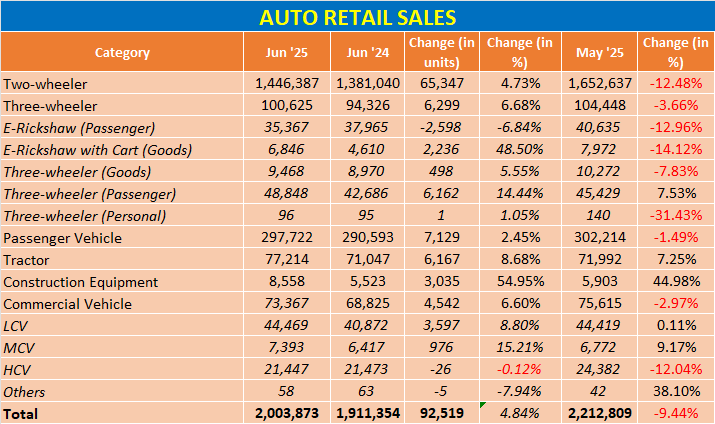
Tata Motors’ PV And CV Sales In The Negative, Outlook Remains Positive
- By MT Bureau
- July 01, 2025
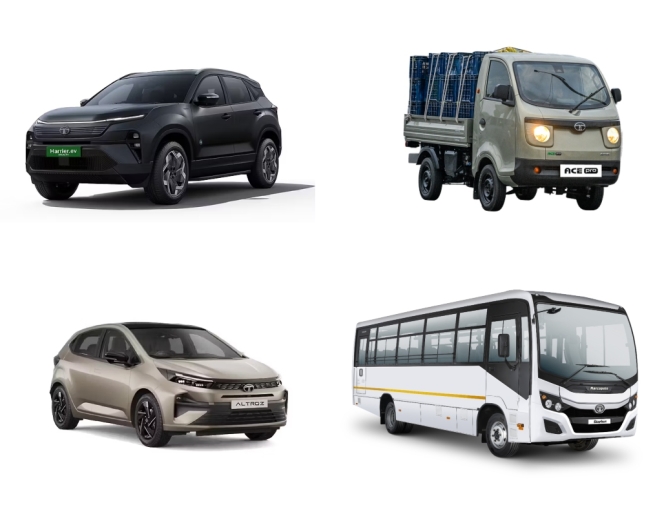
Tata Motors, one of the leading passenger vehicle and commercial vehicle manufacturers in the country, has announced its wholesales for June 2025 and Q1 FY2026.
The company reported that its total PV sales came at 124,809 units in Q1 FY2026, down 10 percent from Q1 FY2025 on a YoY basis. Domestic PV sales, including EVs, came at 123,839 units, down 10 percent YoY. For June, PV sales came at 37,083 units, down 15 percent compared to the same period last year.
| TATA MOTORS PASSENGER VEHICLES | ||||||
| June '25 | June '24 | Change (in %) | Q1 '26 | Q1 '25 | Change (in %) | |
| PV Domestic (includes EV) | 37,083 | 43,524 | -15% | 123,839 | 138,104 | -10% |
| PV IB | 154 | 100 | 54% | 970 | 578 | 68% |
| Total PV (includes EV) | 37,237 | 43,624 | -15% | 124,809 | 138,682 | -10% |
| EV (IB + Domestic) | 5,228 | 4,657 | 12% | 16,231 | 16,579 | -2% |
Shailesh Chandra, Managing Director, Tata Motors Passenger Vehicles and Tata Passenger Electric Mobility, said, “In Q1 FY2026, the passenger vehicle industry experienced volume pressures, particularly in May and June, with flat growth reflecting continued softness in demand."
"The electric vehicle segment emerged a bright spot, driven by robust growth and the launch of new EV models across OEMs, enhancing customer interest and consideration. Tata Motors reported wholesales of 124,809 units in Q1 FY2026, including 16,231 EV units, underscoring our commitment to aligning wholesale and registration volumes. EV sales gained strong momentum towards the end of the quarter with a healthy growth trajectory. The refreshed Tiago posted 16 percent YoY volume growth in Q1 FY2026 and new launches – Altroz and Harrier.ev – saw a positive market response, with their full impact expected in the coming months,” he said.
On the other hand, Tata Motors’ commercial vehicle (CV) business reported sales of 85,606 units, down 6 percent YoY for Q1 FY2026. Domestic CV sales at 79,572 units, were down 9 percent as compared to Q1 FY2025.
In June 2025 alone, total CV sales came at 30,238 units, which is 5 percent lower than June 2024. In the domestic market, the demand for Medium and Heavy Commercial Vehicles (MH&ICV) came at 12,871 units, as against 4,640 units for the same period last year. During Q1 FY26, MH&ICV domestic sales were 37,370 units as against 40,349 units in Q1 FY25.
| TATA MOTORS COMMERCIAL VEHICLES | ||||||
| June '25 | June '24 | Change (in %) | Q1 '26 | Q1 '25 | Change (in %) | |
| HCV Trucks | 7,359 | 8,891 | -17% | 21,735 | 24,690 | -12% |
| ILMCV Trucks | 4,863 | 4,997 | -20% | 14,497 | 13,791 | -20% |
| Passenger Carriers | 5,658 | 5,654 | 4% | 15,089 | 14,893 | 9% |
| SCV Cargo & Pickup | 10,056 | 11,081 | 1% | 28,251 | 34,241 | 4% |
| Total CV Domestic | 27,936 | 30,623 | -9% | 79,572 | 87,615 | -9% |
Girish Wagh, Executive Director, Tata Motors, said, “Q1 FY26 began on a subdued note for the commercial vehicle industry with muted performance in the HCV and SCVPU segments while buses, vans and ILMCVs registered modest year-on-year growth. Tata Motors Commercial Vehicles recorded domestic sales of 79,572 units, 9.2 percent decline compared to Q1 FY25."
"However, June 2025 witnessed a sequential growth of 8 percent over May 2025. Additionally, our International Business delivered a robust 67.9 percent growth in volumes over Q1 FY25. During the quarter, we launched India’s most affordable mini-truck, the Ace Pro, offered in petrol, bi-fuel and electric powertrains, which received an encouraging market response. We enhanced driver comfort by introducing air-conditioned cabins across our entire range of light to heavy trucks. We also expanded our international footprint by entering Egypt and expanded our offerings for the Middle East North African region,” Wagh added.
Going forward, Wagh stated that with forecasts for a healthy monsoon across the country, a reduction in repo rate and renewed thrust on infrastructure development, will bring back sales momentum for the commercial vehicles segment.
Chandra too shared his optimism for the PV market and stated, “Looking ahead, while overall industry growth is expected to remain subdued, Tata Motors is well positioned to leverage its new launches to outperform across segments—including hatchbacks and SUVs, while continuing to build on the EV momentum.”




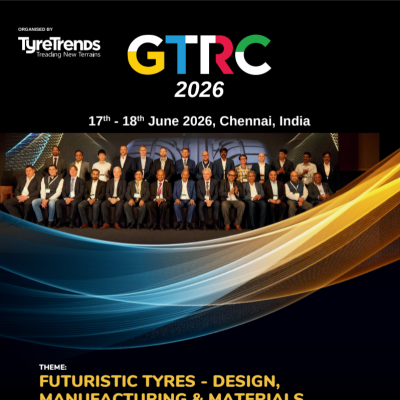
Comments (0)
ADD COMMENT